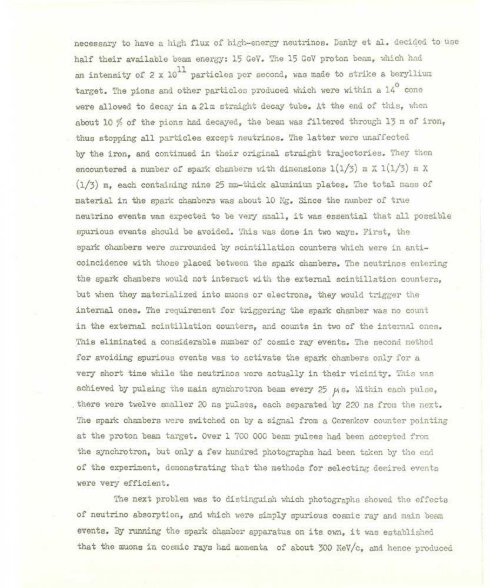introduction-weak-interaction-volume-one
introduction-weak-interaction-volume-one
introduction-weak-interaction-volume-one
Create successful ePaper yourself
Turn your PDF publications into a flip-book with our unique Google optimized e-Paper software.
necessary to have a high flux of high-energy neutrinos . Danby et al . decided to us e<br />
half their available beam energy : 15 GeV . The 15 GeV proton beam, which ha d<br />
an intensity of 2 x 1011 particles per second, was made to strike a berylliu m<br />
target . The pions and other particles produced which were within a 14 c<strong>one</strong><br />
were allowed to decay in a 21m straight decay tube, At the end of this, whe n<br />
about 10 5 of the pions had decayed, the beam was filtered through 13 m of iron ,<br />
thus stopping all particles except neutrinos . The latter were unaffected<br />
by the iron, and continued in their original straight trajectories . They then<br />
encountered a number of spark chambers with dimensions 1(1/3) m X 1(1/3) m X<br />
(1/3) m, each containing nine 25 mm-thick aluminium plates . The total mass o f<br />
material in the spark chambers was about 10 i• :g . Since the number of true<br />
neutrino events was expected to be very small, it was essential that all possible<br />
spurious events should be avoided . This was d<strong>one</strong> in two ways . First, th e<br />
spark chambers were surrounded by scintillation counters which were in anti -<br />
coincidence with those placed between the spar's chambers . The neutrinos entering<br />
the spark chambers would not interact with the external scintillation counters ,<br />
but when they materialized into muons or electrons, they would trigger the<br />
internal <strong>one</strong>s . The requirement for triggering the spark chamber was no coun t<br />
in the external scintillation counters, and counts in two of the internal <strong>one</strong>s .<br />
This eliminated a considerable number of cosmic ray events. The second method<br />
for avoiding spurious events was to activate the spark chambers only for a<br />
very short time while the neutrinos were actually in their vicinity. This wa s<br />
achieved by pulsing the main synchrotron beam every 25 'As . Within each pulse ,<br />
, there were twelve smaller 20 ns pulses, each separated by 220 ns from the next .<br />
The spark chambers were switched on by a signal from a Cerenkov counter pointing<br />
at the proton beam target . Over 1 700 000 beam pulses had been accepted fro m<br />
the synchrotron, but only a few hundred photographs had been taken by the en d<br />
of the experiment, demonstrating that the methods for selecting desired event s<br />
were very efficient .<br />
The next problem was to distinguish which photographs showed the effect s<br />
of neutrino absorption, and which were simply spurious cosmic ray and main beam<br />
events . By running the spark chamber apparatus on its own, it was establishe d<br />
that the muons in cosmic rays had momenta of about 300 MeV/c, and hence produced



